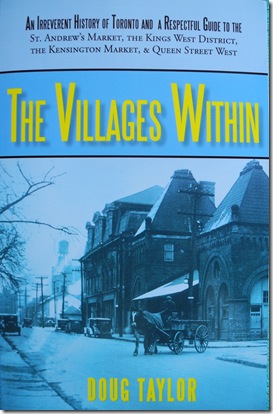“The Villages Within,” nominated for the 2011 Toronto Heritage Awards, is an unabashed promotion of the merits of Toronto. Its cover depicts a 1920s photograph from the Toronto Archives, which shows the buildings of the old St. Andrew’s Market, which once existed near Brant and Adelaide Streets. The buildings were demolished in the late 1930s. The view is looking east along Richmond Street West toward Brant Street and Spadina Avenue.
The book contains a detailed history of this historic market, which was first established in 1837. The book also contains walking tours of Queen Street West, the King’s Spadina area, and the Kensington Market.
However, the introductory section of the book is a disrespectful version of Toronto’s history. As the author clearly has a love affair with the city, he feels entitled to “spoof” it’s history without anyone accusing him of being Torontophobic.
Below is a brief excerpt from the introduction of the book.
When I state, “Toronto is a hell of a town,” I utter the words with a sense of awe. However, I am aware that many Canadians would revise this statement and say, “Toronto is hell.” Some of our national cultural gurus declare that complaining about Toronto is the true national sport, far surpassing in popularity baseball, ice hockey, or even “mattress hockey,” in which they consider “high-sticking” an asset. Others state that bitching about Toronto provides the glue that binds our country together. Perhaps there is some truth to these ideas, as I have encountered Torontophobes from the Atlantic coast to the Pacific shores, their numbers exceeding the proliferation of “Tim-bits” strewn across the nation.
Canadians living beyond Toronto’s borders, decry its flat, boring landscape. They are oblivious of its deep river valleys and the heights of the Davenport Road hill that sweeps across the city, providing impressive panoramas of the downtown, huddled around the shores of the lake. Critics proclaim that Toronto’s citizens clog the city-streets in excessive numbers. However, this is usually not a problem, unless it is an extremely hot day and deodorant is in short supply—travelling on the subway is a noticeable exception.
Critics claim that Toronto’s crime rates are devastating despite statistics proving it is one of the safest cities in the world. We suspect that the city’s worst crime is claiming the title, “The Nation’s Largest Urban Centre.” I suppose it is human nature to pull down anything that is “at the top.”
Some complain that the litter on the streets of Toronto is knee-deep, and the waterfront is a disgrace. There is too much urban sprawl, and smog is choking everyone to death. They are amazed by the depth of evil that haunts Toronto. What is even more amazing, the majority of the city’s detractors have never even set foot within its precincts. However, they know that Toronto is a loser’s town as they have watched “Hockey Night in Canada.”
Canadians from other provinces, and even those who live in Ontario beyond the boundaries of the GTA, state that Torontonians are completely “urbancentric,” believing that their city is superior to every other place in Canada. In other words, they say, “The residents of Toronto think that their shit doesn’t stink.” If only this were true. Too many Torontonians complaint about the city’s lack of this, that, or the other, constantly demonstrating that they possess very little “urbancentricity.” Others are actually proud of their city, but are reluctant to express it.
Another complaint from Torontophoebes is that the city sucks vast fortunes from the federal government, to the detriment of every other region in Canada. They claim that they are able to hear the sucking noise as Toronto vacuums the cash from Ottawa and empties it into the vaults on Bay Street. However, it is more likely that the noise is the sound of government officials flushing “Toronto-phobic” ideas into the empty spaces between the ears of the members of parliament, as well as susceptible voters in the other regions of Canada. Contrary to well-established scientific principles, in this instance, sound can travel in a vacuum.
